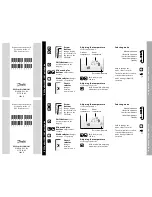
A 3 Glossary
A 3 Glossary
Abosolute zero: The lowest theoretical temperature. At
absolute zero, a body would have no molecular motion
of heat energy. Absolute zero is the zero point on the
Rankine and Kelvin scale. (-273.15 C or -459.67 F)
Abosolute zero: The lowest theoretical temperature. At
absolute zero, a body would have no molecular motion
of heat energy. Absolute zero is the zero point on the
Rankine and Kelvin scale. (-273.15 C or -459.67 F)
AC: Alternating Current; an electric current that reverses
direction at regularly occurring intervals.
AC: Alternating Current; an electric current that reverses
direction at regularly occurring intervals.
Accuracy
Calibration accuracy:
Control accuracy:
Display accuracy:
Set point accuracy:
The potential error of a device
compared to a physical constant or agency
standard.
Maintaining a process at the desired
setting. The errors or combination of errors in the
entire system including the sensor, control, power,
load and design inefficiencies affect control accuracy.
The amount of potential error
between a measured value and the control's
displayed value.
The potential error between a
measured value and the control setting.
Accuracy
Calibration accuracy:
Control accuracy:
Display accuracy:
Set point accuracy:
The potential error of a device
compared to a physical constant or agency
standard.
Maintaining a process at the desired
setting. The errors or combination of errors in the
entire system including the sensor, control, power,
load and design inefficiencies affect control accuracy.
The amount of potential error
between a measured value and the control's
displayed value.
The potential error between a
measured value and the control setting.
Alarm: A control condition or function, indicating that the
process is a predetermined amount above or below the
set point.
Alarm: A control condition or function, indicating that the
process is a predetermined amount above or below the
set point.
Alpha ( ): The average percent change in resistance per
degree of a pure metal resistance device between 0
and 100 C. Usually designated by the Greek letter
alpha,
with units of ohm/ohm/ C. The common alpha
for a platinum RTD is 0.00385 ohm/ohm/ C.
Alpha ( ): The average percent change in resistance per
degree of a pure metal resistance device between 0
and 100 C. Usually designated by the Greek letter
alpha,
with units of ohm/ohm/ C. The common alpha
for a platinum RTD is 0.00385 ohm/ohm/ C.
Ambient compensation: The design of an instrument such
that changes in ambient temperature do not affect the
readings of the instrument.
Ambient compensation: The design of an instrument such
that changes in ambient temperature do not affect the
readings of the instrument.
Ambient temperature: The average or mean temperature
of the surrounding air which comes in contact with the
equipment and instruments under test.
Ambient temperature: The average or mean temperature
of the surrounding air which comes in contact with the
equipment and instruments under test.
Ampere (amp): A unit used to define the rate of flow of
electricity (current) in a circuit; units are one coulomb
(6.25 x 10
electrons) per second.
Ampere (amp): A unit used to define the rate of flow of
electricity (current) in a circuit; units are one coulomb
(6.25 x 10
electrons) per second.
18
Analog indication: A meter with graduated scale and a
pointer that moves to indicate process condition.
Analog indication: A meter with graduated scale and a
pointer that moves to indicate process condition.
Analog output: A voltage or current signal that is a
continuous function of the measure parameter.
Analog output: A voltage or current signal that is a
continuous function of the measure parameter.
Analog set point: Potentiometer adjustment of the control
setting.
Analog set point: Potentiometer adjustment of the control
setting.
ANSI: American National Standards Institute
ANSI: American National Standards Institute
Anti-reset windup: This is a feature in a three-mode PID
controller which prevents the integral (auto reset) circuit
from functioning when the temperature is outside the
proportional band.
Anti-reset windup: This is a feature in a three-mode PID
controller which prevents the integral (auto reset) circuit
from functioning when the temperature is outside the
proportional band.
ASME: American Society of Mechanical Engineers.
ASME: American Society of Mechanical Engineers.
ASTM: American Society for Testing and Materials.
ASTM: American Society for Testing and Materials.
Automatic reset (Integral): The integral function of a
control that automatically compensates for the
difference between the set point and the actual process
temperature. A signal moves the proportional band
up or down to correct for the droop or offset error.
Automatic reset (Integral): The integral function of a
control that automatically compensates for the
difference between the set point and the actual process
temperature. A signal moves the proportional band
up or down to correct for the droop or offset error.
Automatic tuning (of control parameters): A control that
calculates the optimum PID parameters with a built-in
software algorithm to eliminate manual tuning efforts.
Automatic tuning (of control parameters): A control that
calculates the optimum PID parameters with a built-in
software algorithm to eliminate manual tuning efforts.
AWG: American Wire Gauge.
AWG: American Wire Gauge.
Bandwidth: A symmetrical region around the set point in
which proportional control occurs.
Bandwidth: A symmetrical region around the set point in
which proportional control occurs.
Baud rate: In serial communications, the rate of
information transfer in bits per second.
Baud rate: In serial communications, the rate of
information transfer in bits per second.
Blackbody: A theoretical object that radiates the maximum
amount of energy at a given temperature, and absorbs
all the energy incident upon it. A blackbody is not
necessarily black. (The name blackbody was chosen
because the color black is defined as the total
absorption of light [energy].)
Blackbody: A theoretical object that radiates the maximum
amount of energy at a given temperature, and absorbs
all the energy incident upon it. A blackbody is not
necessarily black. (The name blackbody was chosen
because the color black is defined as the total
absorption of light [energy].)
Boiling point: The temperature at which a substance in
the liquid phase transforms to the gaseous phase;
commonly refers to the boiling point of water which is
100 C (212 F) at sea level.
Boiling point: The temperature at which a substance in
the liquid phase transforms to the gaseous phase;
commonly refers to the boiling point of water which is
100 C (212 F) at sea level.
Btu: British Thermal Unit. The quantity of thermal energy
required to raise one pound of water 1 F at or near its
maximum density (39.1 F).
Btu: British Thermal Unit. The quantity of thermal energy
required to raise one pound of water 1 F at or near its
maximum density (39.1 F).
Bumpless transfer: The smooth, automatic transition from
automatic control (closed loop) to manual control (open
loop). The control output is maintained during the
transfer.
Bumpless transfer: The smooth, automatic transition from
automatic control (closed loop) to manual control (open
loop). The control output is maintained during the
transfer.
Burst proportioning: A fast-cycling output form on a time
proportioning controller (typically adjustable from .2 to
4 seconds) used in conjunction with a solid state relay
to prolong the life of heaters by minimizing thermal
stress.
Burst proportioning: A fast-cycling output form on a time
proportioning controller (typically adjustable from .2 to
4 seconds) used in conjunction with a solid state relay
to prolong the life of heaters by minimizing thermal
stress.
Calender-van Dusen equation: An equation that defines
the resistance-temperature value of any pure metal that
takes the form of R = R (1 + AT + BT ) for values
between the ice point (0 C) and the freezing point of
antimony (630.7 C) and the form R = R [1 + AT +
BT + C( T-100)T ] between the oxygen point (-183.0
C) and the ice point (0 C).
Calender-van Dusen equation: An equation that defines
the resistance-temperature value of any pure metal that
takes the form of R = R (1 + AT + BT ) for values
between the ice point (0 C) and the freezing point of
antimony (630.7 C) and the form R = R [1 + AT +
BT + C( T-100)T ] between the oxygen point (-183.0
C) and the ice point (0 C).
T
T
O
O
2
2
2
Calibration: The process of adjusting an instrument so that
the indication is accurate compared to the actual value.
Calibration: The process of adjusting an instrument so that
the indication is accurate compared to the actual value.
Calorie: The quantity of thermal energy required to raise
one gram of water 1 C at 15 C.
Calorie: The quantity of thermal energy required to raise
one gram of water 1 C at 15 C.
129
Cascade: Control in which the output of a secondary or
inner control loop is the set point for a primary or outer
loop. The primary loop, in turn, determines the control
action.
Cascade: Control in which the output of a secondary or
inner control loop is the set point for a primary or outer
loop. The primary loop, in turn, determines the control
action.
UM25001H














































